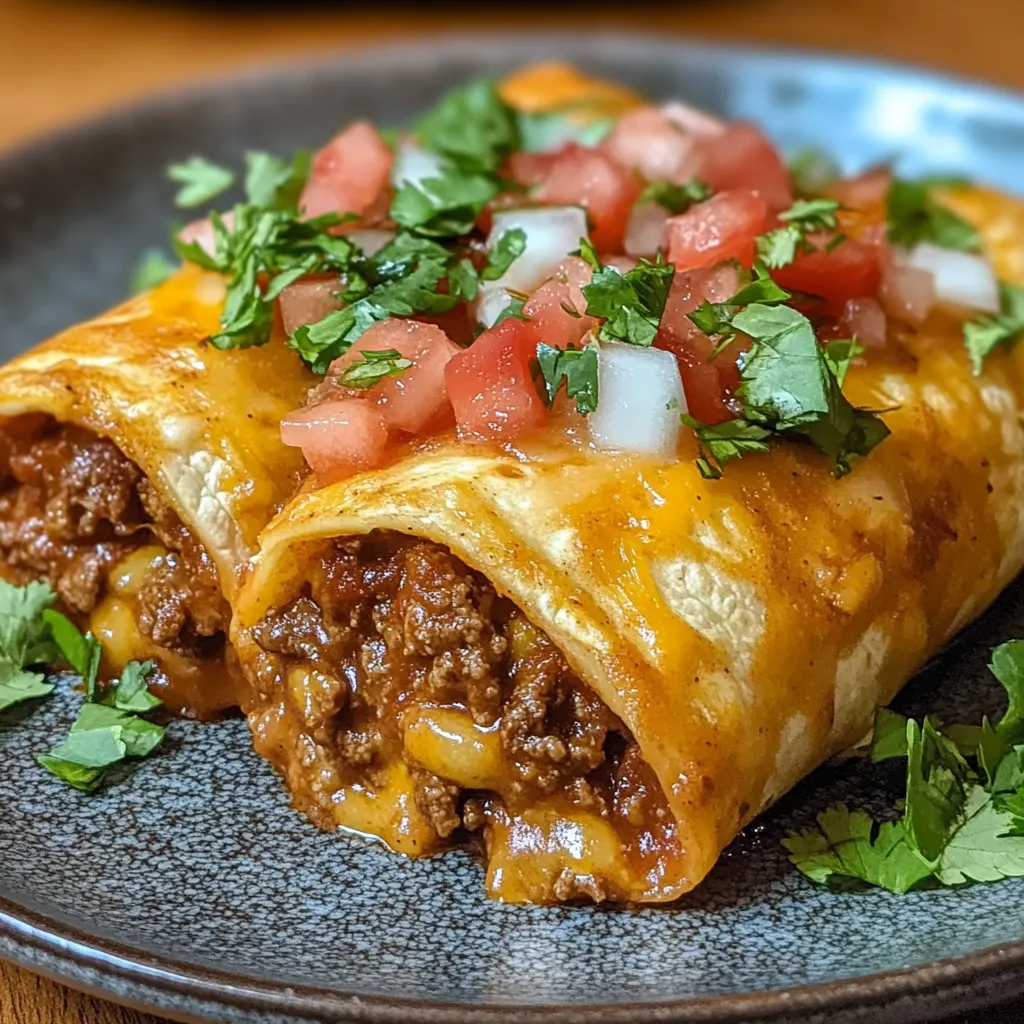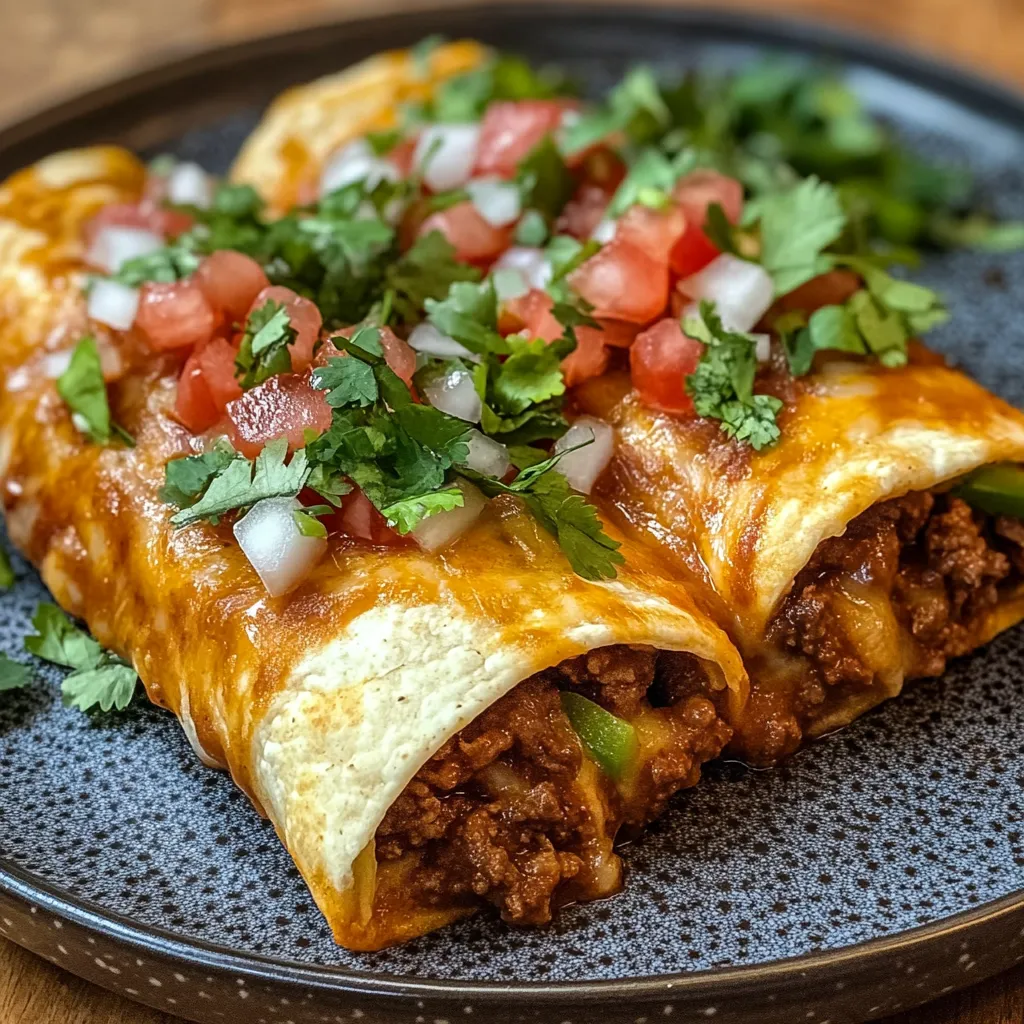 Pin it
Pin it
Ground beef and cheese rolled up in flour tortillas then fried to a golden crunch—that's what makes chimichangas so darn good. They mix simple stuff into something amazing. I picked up this cooking trick while living in Texas and found out I could nail these at home, not just get them at restaurants. These Tex-Mex treats bring real southwestern taste to your dinner in about half an hour, which works great for busy nights or when you want to impress friends on the weekend.
The first time I tried making chimichangas at home was a total flop. They turned into oil-soaked mush with filling spilling everywhere and patchy browning. After a bunch of tries and some tips from my neighbor (whose mom grew up in El Paso), I figured out you've gotta roll them tight and put them seam-down in the oil first. Now we make them once a month, and my husband actually likes them better than the ones from our local Mexican spot.
What You'll Need
- Flour tortillas: Go for the big burrito size (10-12 inches) that feel soft and bendy when you touch them; stiff or dry ones will split open when you roll them
- Ground beef: Pick 80/20 meat for the right mix of taste and juiciness; too lean gets dry, too fatty makes soggy filling
- Refried beans: They add flavor and work like glue to keep everything together; pinto beans make it creamier, but black beans taste great too
- Shredded cheese: Grab a block and grate it yourself—it melts way better than the pre-shredded bags; mixing cheddar and Monterey Jack gives you the best flavor and melt
- Chili powder: You can't make good Tex-Mex without it; I like to heat mine in a dry pan for half a minute first to wake up the flavor
- Cumin: This gives that earthy smell that screams southwestern cooking; buying whole seeds and grinding them yourself makes it taste so much better
- Oregano: Try to find Mexican oregano since it tastes totally different from the Italian kind; it's got this wild, citrusy thing going on
- Vegetable oil: Use something with no strong taste that can handle high heat; I really like peanut oil because it fries clean and doesn't mess with the flavor
Instructions
- Cook that beef right:
- Start with a really hot pan so the meat browns instead of steams. Break it into tiny bits while it cooks and stir now and then until you don't see any pink left. This browning is what makes it taste so good. Dump it in a strainer to get rid of the extra fat that would make your chimichangas all soggy.
- Make the meat taste amazing:
- Put the drained beef back in the pan over medium heat. Throw in all your spices plus some water and mix it all up. The water helps the spices bloom and coats the meat nicely. Let it bubble gently until the liquid's gone and the flavors get stronger. Give it a taste and add more salt if needed before turning off the heat.
- Get your oil ready:
- Pour vegetable oil into a heavy pan about half an inch deep. Heat it up to around 375°F, which takes maybe 5-7 minutes on medium heat. If you don't have a thermometer, drop in a tiny piece of tortilla—it should bubble up right away but not turn dark too fast.
- Make your tortillas flexible:
- Quickly pass each tortilla over a flame or warm it in a dry pan for a few seconds on each side. This makes them soft so they won't crack when you roll them. Keep them under a kitchen towel so they stay warm while you work.
- Put them together carefully:
- Lay out a warm tortilla and spread about a spoonful of refried beans in a line near one edge, but leave about an inch of space. Add a couple spoonfuls of seasoned meat on top, then sprinkle plenty of cheese. Don't stuff them too full—that's how they burst when frying.
- Roll them up tight:
- Fold the edge closest to the filling over the mix, tucking it under a bit to make a tight roll. Fold both sides in like you're making an envelope, then keep rolling away from yourself until it's all wrapped up. The tighter you roll, the better it stays closed and keeps the filling inside during frying.
- Fry them the smart way:
- Using tongs, carefully place each chimichanga seam-side down first in the hot oil. This seals the edge shut. Fry for 1-2 minutes until golden brown, then gently turn to cook all sides evenly. Use the tongs to hold them in place to brown the ends too, so they're crispy all over.
- Let them drain good:
- Move them to a plate lined with paper towels, making sure they don't touch each other. Pat the tops with more paper towels. Let them sit for a couple minutes before serving so the inside sets up and the outside gets super crispy.
 Pin it
Pin it
My family runs "Chimichanga Fridays" during summer when my sister brings her kids over. The grown-ups love topping theirs with homemade green salsa and a little Mexican crema, while the kids pile on mountains of lettuce, tomatoes and sour cream. My brother-in-law once ate four in one sitting—they're seriously that good!
Variations to Try
I've played around with tons of filling ideas over the years. Try shredded chicken cooked in salsa verde for a bright, zingy version that goes perfectly with pepper jack cheese. Want something with deeper flavor? Add a spoonful of that red sauce from canned chipotle peppers to your beef mixture.
For my veggie friends, I cook diced bell peppers, onions, corn, and zucchini until they get all caramelized, then mix them with black beans and a bit of smoked paprika. Even the hardcore meat-eaters ask for this version when they come over. Just make sure you cook out all the extra water from the veggies before you roll them up.
On weekends, I love using leftover slow-cooked pork shoulder or brisket, shredded up and mixed with a splash of BBQ sauce. The smoky meat wrapped in that crispy shell creates this amazing flavor that's somewhere between Tex-Mex and southern barbecue.
Serving Suggestions
The classic way to serve chimichangas is with Spanish rice and refried beans on the side. But for something fresher, try them with cilantro-lime rice and a simple cabbage slaw dressed with just lime juice and salt—the tanginess helps balance out the rich, fried goodness.
One thing that goes amazingly well with chimichangas but often gets forgotten is pickled red onions. Those tangy, bright pink rings cut through the richness perfectly. Just slice an onion really thin, soak it in lime juice with a pinch of salt for half an hour, and you're good to go.
When friends come over, I set up a chimichanga bar where everyone can add their own toppings. Put out bowls of shredded lettuce, chopped tomatoes, sliced avocado, different salsas, sour cream, and hot sauces. It's fun and everyone gets to make theirs exactly how they want it.
 Pin it
Pin it
Conclusion
I've spent the last fifteen years tweaking this recipe since moving away from Texas, and it's now what I'm known for when I have people over. There's nothing like watching friends take that first bite and hearing that crunch as the crispy shell gives way to all that tasty filling. Food has always been how I show love, and these chimichangas do it perfectly. They've helped so many of my friends discover the joy of homemade Tex-Mex, proving you don't need to go out to get those authentic southwestern flavors. With a bit of practice, you'll be making restaurant-quality chimichangas that your family will beg for every week.
Frequently Asked Questions
- → Can I make these wraps in the oven instead of frying?
- Absolutely! Lightly coat the rolled wraps with oil and pop them in a 400°F oven for about 20 minutes. Flip them halfway to get them evenly crispy.
- → How can I freeze these for later?
- After rolling but before frying, wrap them up individually with plastic wrap, then toss them in a freezer-safe bag. Freeze for up to 3 months. Thaw overnight in the fridge before frying as usual.
- → What can I use if I don't want ground beef?
- Ground chicken, turkey, or even plant-based alternatives work great. You can also try shredded chicken, pork, or beef—just tweak the spices to suit your choice.
- → Why do my wraps fall apart when frying?
- Roll them tightly and lay them seam-side down first in the hot oil. You can secure them with toothpicks while frying—just don’t forget to remove them before eating!
- → What sides go well with these wraps?
- Pair with black beans, corn salad, Mexican-style rice, or a fresh green salad. Add guac, salsa, and lime wedges as extra toppings to finish the meal.
